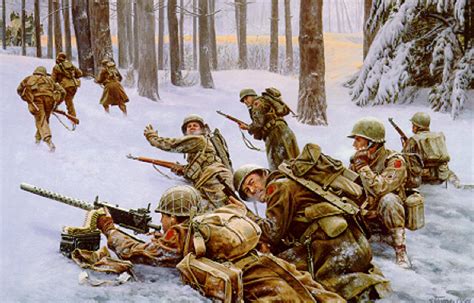
A little-known U.S. Army division, the 106th, often dismissed as inexperienced, played a pivotal but largely unacknowledged role in blunting the initial force of the German offensive during the Battle of the Bulge in December 1944, buying critical time for reinforcements and ultimately contributing to the Allied victory.
The 106th Infantry Division, derisively nicknamed “the kids” due to the youth and inexperience of its soldiers, found itself in a crucial defensive position in the Schnee Eifel region when the German army launched its massive surprise attack on December 16, 1944. Tasked with holding a seemingly quiet sector of the front lines, the division bore the brunt of the initial assault, a scenario they were woefully unprepared for given their recent arrival in Europe and lack of combat experience. The common belief was that this sector was inactive and designed for newer troops to acclimate to the European theater.
“They were ridiculed as being an inexperienced division,” said historian Peter Caddick-Adams, yet their stand proved vital in delaying the German advance. Despite suffering heavy casualties and the eventual surrender of two of its regiments, the 106th’s determined resistance disrupted the German timetable and allowed General Dwight D. Eisenhower to redeploy forces to contain the offensive. The division’s sacrifice significantly impacted the overall outcome of the battle, providing the necessary window for Allied forces to regroup and mount a counteroffensive.
The Battle of the Bulge, Germany’s last major offensive on the Western Front, aimed to split the Allied armies and recapture the vital port of Antwerp, Belgium. Had the Germans succeeded, it could have drastically altered the course of World War II. The 106th Infantry Division’s unexpected valor in the face of overwhelming odds highlights the often-overlooked contributions of ordinary soldiers in extraordinary circumstances.
The division’s position in the Schnee Eifel, considered a quiet sector, proved to be anything but. “They were sitting up there in what everybody thought was a very quiet sector,” Caddick-Adams explained. “Suddenly, the Germans attacked and just rolled straight through them.” The speed and intensity of the German assault caught the 106th off guard, but despite their lack of experience, they fought fiercely.
The two regiments of the 106th that were forced to surrender represented one of the largest mass surrenders of U.S. troops during the war. However, the time bought during their resistance allowed for the 7th Armored Division to move into position, thus preventing a complete breakthrough and the rapid capture of key strategic locations.
The stand of the 106th is now being re-evaluated by historians who are uncovering evidence of their impact. Their struggle significantly delayed the German advance. This delay was crucial for the Allied forces, who were able to use this time to prepare for a counterattack. The division’s initial resistance bought time for reinforcements to arrive, and allowed the Allies to strategically position their forces and mount a successful defense. Historians note that without the 106th Infantry Division’s resilience, the outcome of the Battle of the Bulge could have been drastically different.
The experience of the 106th Division underscores the chaotic and unpredictable nature of war, where even inexperienced troops can play a decisive role. Their story serves as a reminder of the bravery and sacrifice of all those who fought in the Battle of the Bulge, including those whose contributions have been historically underappreciated.
The role of the 106th has been minimized historically for multiple reasons. The large surrender of two regiments cast a shadow over the division’s overall performance. The focus on more celebrated units and heroic narratives within the Battle of the Bulge also contributed to the neglect of the 106th’s story. The lack of immediate strategic success and the overwhelming nature of their initial defeat further contributed to their being overlooked. However, a deeper analysis of the battle’s timeline reveals that their resistance, however brief, played a pivotal role.
Now, the story of the 106th is being brought to light. Historians are starting to recognize the value of their contribution. Through meticulous research and analysis, the impact of their defense has been made apparent. Oral histories, archival records, and after-action reports are shedding light on the division’s struggle and bravery. By recognizing their role, the historical narrative of the Battle of the Bulge becomes more complete and nuanced.
The Schnee Eifel region, where the 106th made its stand, was a heavily wooded and hilly area. The terrain favored the German attackers, who were able to use the dense forests to conceal their movements. The harsh winter conditions further complicated the defense, with snow, ice, and freezing temperatures adding to the challenges faced by the American soldiers. The lack of proper winter gear and the inexperience of the troops made the situation even more dire. The weather conditions contributed significantly to the casualties suffered by the 106th.
The impact of the 106th Infantry Division’s actions on the broader war effort cannot be overstated. By slowing the German advance, they prevented the enemy from achieving their initial objectives. The delay allowed the Allies to reinforce key positions, ultimately leading to the defeat of the German offensive. The Battle of the Bulge was a turning point in the war, and the 106th’s contribution was a crucial factor in the Allied victory.
In conclusion, the story of the 106th Infantry Division is one of courage, sacrifice, and resilience. Despite their inexperience and the overwhelming odds they faced, they stood their ground and fought valiantly. Their actions played a critical role in the Battle of the Bulge, and their contribution to the Allied victory should not be forgotten. By recognizing their bravery and sacrifice, we honor the memory of all those who fought in the war and ensure that their story is never forgotten. The reassessment of their role emphasizes the importance of acknowledging the contributions of all soldiers, regardless of their unit’s reputation or the immediate outcome of their engagements.
The division’s experience highlights the human cost of war and the importance of remembering the sacrifices made by ordinary soldiers. It serves as a reminder that every soldier, regardless of their experience level, has the potential to make a significant contribution. The story of the 106th underscores the need for thorough training and preparation for all soldiers entering combat zones. Their experience underscores the necessity of adequately preparing soldiers for the realities of war, regardless of where they are deployed.
The Battle of the Bulge remains one of the most significant and hard-fought battles in American military history. The courage and determination of the American soldiers who fought in the battle, including the often-overlooked 106th Infantry Division, played a crucial role in the Allied victory. Their story is a testament to the human spirit and a reminder of the sacrifices made to defend freedom and democracy. Recognizing and remembering their contributions is essential to honoring their legacy and ensuring that their story is never forgotten. The ongoing efforts to reassess and highlight the role of the 106th demonstrate a commitment to historical accuracy and a deeper understanding of the complexities of war.
The Strategic Significance of the Battle of the Bulge
The Battle of the Bulge, launched on December 16, 1944, by the German Wehrmacht, was a desperate attempt to reverse the Allied advance into Germany during the final months of World War II. The German plan, known as Operation Wacht am Rhein (Watch on the Rhine), aimed to break through the Allied lines in the Ardennes Forest, recapture the port of Antwerp in Belgium, and split the Allied forces, thereby forcing them to negotiate a peace treaty. Antwerp was crucial to the Allies because it was their primary supply port. Capturing it would have severely disrupted their logistical capabilities, potentially stalling their advance into Germany.
The Ardennes region was chosen for the offensive because it was lightly defended, with the German military intelligence believing that the Allies would not expect a major attack in that area due to the difficult terrain and the assumption that the Germans were too weak to launch such an ambitious operation. The Allies had indeed underestimated the German capacity to mount a large-scale offensive at this stage of the war, and their defenses in the Ardennes were thinly stretched, manned primarily by inexperienced troops and those recovering from previous battles.
The German attack caught the Allies by surprise, and the initial stages of the offensive were successful. German forces penetrated deep into the Allied lines, creating a large bulge in the front lines, hence the name “Battle of the Bulge.” The offensive threatened to disrupt the entire Allied war effort, and the outcome of the battle was far from certain in the early days.
The strategic implications of a successful German offensive were dire for the Allies. If the Germans had managed to recapture Antwerp and split the Allied forces, it could have prolonged the war significantly, potentially leading to a negotiated peace that would have allowed Germany to retain control of some of its conquered territories. This would have had profound consequences for the post-war world, altering the balance of power and potentially allowing the Nazi regime to survive longer.
The Battle of the Bulge also had significant political implications. It tested the strength of the Allied coalition and strained relations between the Allied leaders. General Dwight D. Eisenhower, the Supreme Commander of the Allied Expeditionary Force, faced immense pressure to contain the German offensive and prevent a disastrous outcome. The battle also affected morale on both sides, with the initial German successes boosting German morale and causing concern among the Allied forces.
Ultimately, the Allies were able to repel the German offensive, but not without significant losses. The Battle of the Bulge was one of the bloodiest battles of World War II for the American forces, with over 89,000 casualties, including nearly 19,000 killed. The battle exhausted the German war machine, however, and depleted its resources, contributing to its eventual defeat.
The 106th Infantry Division: A Closer Look at Their Role
The 106th Infantry Division’s experience exemplifies the challenges faced by newly deployed troops in wartime. Arriving in Europe in late 1944, the division was assigned to a sector considered relatively quiet, providing them with a supposed opportunity to acclimate to the conditions of war before being thrust into major combat operations. However, this perception of a “quiet sector” proved tragically wrong.
The division’s deployment to the Schnee Eifel region placed them in a strategically important location, unknowingly in the path of the impending German offensive. The sector was lightly defended, reflecting the Allied belief that the Germans were incapable of launching a major attack in that area. This misjudgment left the 106th vulnerable and ill-prepared for the onslaught that was about to come.
When the German offensive began on December 16, 1944, the 106th Infantry Division bore the brunt of the attack. The division’s inexperience and lack of combat experience were immediately exposed as they faced a determined and well-equipped German force. The speed and intensity of the German assault overwhelmed the 106th, causing widespread confusion and disarray.
Despite their initial setbacks, the soldiers of the 106th fought bravely, attempting to hold their ground against the overwhelming German forces. However, their lack of experience and the sheer scale of the attack made their task nearly impossible. The division suffered heavy casualties, and two of its regiments were eventually surrounded and forced to surrender, resulting in one of the largest mass surrenders of American troops during the war.
While the surrender of these regiments was a significant blow, the resistance put up by the 106th Infantry Division bought valuable time for the Allied forces. Their defense, however brief, disrupted the German timetable and allowed General Eisenhower to redeploy forces to contain the offensive. The delay caused by the 106th’s resistance proved crucial in preventing a complete German breakthrough and allowed the Allies to reinforce key positions.
The 106th’s experience highlights the importance of thorough training and preparation for all soldiers entering combat zones. Their lack of experience and the unexpected intensity of the German attack exposed the vulnerabilities of deploying inexperienced troops to the front lines. The division’s story serves as a reminder of the human cost of war and the importance of adequately preparing soldiers for the realities of combat.
The initial negative perception of the 106th Infantry Division, stemming from the surrender of two regiments, has overshadowed their overall contribution to the Battle of the Bulge. However, recent historical analysis has shed new light on their role, revealing that their resistance, however brief, played a critical part in delaying the German advance. By recognizing their contribution, the historical narrative of the Battle of the Bulge becomes more complete and nuanced, acknowledging the sacrifices made by all those who fought in the battle.
Reassessing the Historical Narrative
For many years, the historical narrative of the Battle of the Bulge has focused on the successes of more experienced and celebrated units, such as the 101st Airborne Division at Bastogne. While their contributions were undoubtedly significant, the tendency to focus on these heroic narratives has often overshadowed the contributions of other units, including the 106th Infantry Division.
The reassessment of the 106th’s role in the Battle of the Bulge is part of a broader effort to provide a more complete and accurate historical account of the battle. Historians are now delving deeper into archival records, oral histories, and after-action reports to uncover the stories of those who have been historically overlooked. This research has revealed that the 106th’s resistance, despite their inexperience and the eventual surrender of two regiments, played a crucial role in delaying the German advance.
The delay caused by the 106th’s resistance allowed the Allies to reinforce key positions, preventing a complete German breakthrough and ultimately contributing to the defeat of the German offensive. This reassessment highlights the importance of considering the contributions of all units involved in the battle, regardless of their reputation or the immediate outcome of their engagements.
By recognizing the role of the 106th Infantry Division, the historical narrative of the Battle of the Bulge becomes more nuanced and inclusive, acknowledging the sacrifices made by all those who fought in the battle. This reassessment also serves as a reminder that even inexperienced troops can make a significant contribution in wartime, and that their stories deserve to be told and remembered.
The Human Cost of War
The Battle of the Bulge was one of the bloodiest battles of World War II for the American forces, with over 89,000 casualties. The battle took a heavy toll on both the soldiers and the civilians who were caught in the crossfire. The harsh winter conditions, the intense fighting, and the constant threat of death and injury created a brutal and unforgiving environment.
The soldiers who fought in the Battle of the Bulge endured unimaginable hardships, facing freezing temperatures, relentless enemy fire, and the constant fear of death. Many of them were young and inexperienced, thrust into the horrors of war with little preparation. They fought bravely, displaying courage and resilience in the face of overwhelming odds.
The civilians who lived in the Ardennes region also suffered greatly during the Battle of the Bulge. Their homes were destroyed, their livelihoods disrupted, and many of them were killed or injured. They endured the trauma of living in a war zone, witnessing the destruction and violence that surrounded them.
The Battle of the Bulge serves as a stark reminder of the human cost of war. It highlights the sacrifices made by the soldiers and civilians who were caught in the conflict, and it underscores the importance of striving for peace and preventing future wars. The story of the 106th Infantry Division and their stand during the initial days of the battle is a poignant reminder of the bravery and sacrifice of ordinary soldiers in extraordinary circumstances.
Lessons Learned and Lasting Impact
The Battle of the Bulge provided valuable lessons for the Allied forces, highlighting the importance of intelligence gathering, preparedness, and the need for well-trained and experienced troops. The initial German successes exposed vulnerabilities in the Allied defenses and underscored the need for better intelligence on enemy capabilities and intentions.
The battle also demonstrated the importance of maintaining a strong and resilient logistical system. The German offensive disrupted Allied supply lines, causing shortages of ammunition, fuel, and other essential supplies. This highlighted the need for a robust and adaptable logistical system that could withstand the disruptions of war.
The Battle of the Bulge had a lasting impact on the American military, leading to improvements in training, equipment, and strategy. The lessons learned from the battle were incorporated into military doctrine and training programs, helping to prepare future generations of soldiers for the challenges of modern warfare.
The Battle of the Bulge also had a significant impact on the post-war world. The Allied victory in the battle helped to secure the defeat of Nazi Germany and the end of World War II. The battle also solidified the United States’ position as a global superpower and played a key role in shaping the post-war world order. The memory of the Battle of the Bulge serves as a reminder of the sacrifices made to defend freedom and democracy, and it continues to inspire generations of Americans.
Frequently Asked Questions (FAQ)
-
What was the Battle of the Bulge? The Battle of the Bulge was a major German offensive campaign launched in the Ardennes region of Belgium, France, and Luxembourg in December 1944, during the final months of World War II. The German goal was to split the Allied armies and recapture the port of Antwerp.
-
What role did the 106th Infantry Division play in the Battle of the Bulge? The 106th Infantry Division, despite being relatively inexperienced, was positioned in the Schnee Eifel region and bore the brunt of the initial German assault. Their resistance, although resulting in heavy casualties and the surrender of two regiments, delayed the German advance and bought crucial time for the Allies to regroup.
-
Why has the 106th Infantry Division’s contribution been historically overlooked? The division’s role has been minimized due to the large surrender of two regiments, the focus on other more celebrated units, and the initial perception of their defeat. However, recent historical analysis has highlighted the value of their resistance in delaying the German advance.
-
What were the strategic implications of the Battle of the Bulge? The Battle of the Bulge was a critical moment in the war. If the Germans had succeeded in their objectives, it could have prolonged the war and potentially altered the outcome. The Allied victory ensured the continued advance into Germany and contributed to the eventual defeat of Nazi Germany.
-
How is the story of the 106th Infantry Division being re-evaluated today? Historians are now using archival records, oral histories, and after-action reports to shed light on the 106th’s experience and their contribution to the Battle of the Bulge. This reassessment aims to provide a more complete and nuanced understanding of the battle and to acknowledge the sacrifices made by all soldiers, including those in the 106th.
-
What impact did the terrain and weather conditions have on the 106th Infantry Division during the Battle of the Bulge? The 106th Infantry Division’s stand in the Schnee Eifel region was significantly impacted by the dense forests, hilly terrain, and harsh winter conditions. The wooded areas provided cover for the German attackers, making it difficult for the inexperienced American soldiers to spot and defend against the enemy. The freezing temperatures, snow, and ice added to the challenges, causing casualties and hindering movement. The lack of proper winter gear further exacerbated the situation for the ill-prepared troops.
-
How did the inexperience of the 106th Infantry Division contribute to their struggles during the Battle of the Bulge? The inexperience of the 106th Infantry Division played a significant role in their struggles during the Battle of the Bulge. Having recently arrived in Europe and lacking combat experience, the soldiers were ill-prepared for the intensity and scale of the German assault. Their lack of familiarity with combat tactics, weapons, and the terrain left them vulnerable and overwhelmed by the more seasoned German forces. The inexperience also contributed to communication breakdowns and difficulties in coordinating defensive efforts.
-
What role did General Dwight D. Eisenhower play in the Allied response to the Battle of the Bulge, and how did the 106th’s actions factor into his strategy? General Dwight D. Eisenhower, as the Supreme Commander of the Allied Expeditionary Force, played a crucial role in coordinating the Allied response to the Battle of the Bulge. When the German offensive commenced, Eisenhower quickly recognized the severity of the situation and ordered reinforcements to contain the breakthrough. The 106th Infantry Division’s resistance, despite their eventual surrender, provided Eisenhower with valuable time to redeploy forces, including the 7th Armored Division, to prevent a complete German breakthrough. This delay allowed Eisenhower to strategically position troops and mount a successful defense against the German offensive.
-
What were the specific factors that led to the surrender of two regiments of the 106th Infantry Division? Several factors contributed to the surrender of two regiments of the 106th Infantry Division. The speed and intensity of the German assault, coupled with the division’s inexperience, created widespread confusion and disarray. The division was quickly surrounded and cut off from reinforcements and supplies. Communication breakdowns and the overwhelming number of German troops further weakened the defense. Facing dwindling ammunition, mounting casualties, and the hopelessness of their situation, the regimental commanders made the difficult decision to surrender to prevent further loss of life.
-
How does the reassessment of the 106th Infantry Division’s role in the Battle of the Bulge change our understanding of the battle’s overall history and impact? The reassessment of the 106th Infantry Division’s role in the Battle of the Bulge provides a more complete and nuanced understanding of the battle’s overall history and impact. It highlights the importance of acknowledging the contributions of all soldiers and units involved, regardless of their reputation or immediate outcomes. The reassessment reveals that even inexperienced troops can play a crucial role in delaying the enemy and buying time for reinforcements. By recognizing the sacrifices and bravery of the 106th, the historical narrative becomes more inclusive and accurate, ensuring that their story is not forgotten and that the lessons of the battle are fully understood.









